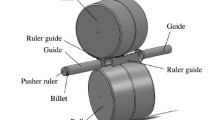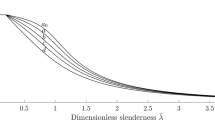Two-high screw piercing of steel 50 billets was performed at feed angles of 15 and 18 degrees. Piercing was stopped at 10–12 mm distance from the rear end of the billet. Axial fracture was registered at 15 degrees feed angle in front of the mandrel nose, while no fracture was observed at 18 degrees feed angle. Piercing for similar parameters was simulated using DEFORM finite element analysis software, and several criteria were used for fracture prediction. Ayada criterion was ineffective, as evidenced by the comparison with experimental data. The normalized Cockcroft–Latham criterion was effective for fracture prediction only in the axial zone. Results of this study showed that the most effective technique for fracture prediction is the construction of a dependence of “accumulated strain–stiffness coefficient of tension” along the trajectory of the point movement.









Similar content being viewed by others
References
P. T. Emel’yanenko, The Theory of Oblique and Pilgrim Rolling [in Russian], Metallurgizdat, Moscow (1949).
A. P. Chekmarev, Ya. L. Vatkin, M. I. Khanin, V. I. Biba, and N. S. Kirvalidze, Piercing in Cross-Roll Mills [in Russian], Metallurgiya, Moscow (1967).
I. A. Fomichev, Skew Rolling [in Russian], Metallurgizdat, Moscow (1963).
K. Gruber, “Uber die Herstellung nahtloser Rohre unter besonderer Berucksichtigung des Mannesmann-Schragwalzverfahrens,” Stahl Eisen, 38, No. 36, 40–42 (1919).
V. K. Vorontsov and V. A. Belevitin, Revisiting the Macrofracture of the Axial Zone of a Solid Billet during Screw Rolling: Proceedings of MISiS, No. 119, “Theory and technology of metal strain,” Metallurgiya, Moscow (1979).
V. L. Kolmogorov, Stresses, Strains, Fracture [in Russian], Metallurgiya, Moscow (1970).
A. A. Bogatov, O. I. Mizhiritskiy, and K. S. Smirnov, Resource of Metal Ductility during Pressure Treatment [in Russian], Metallurgiya, Moscow (1984).
K. L. Kolmogorov, A. A. Bogatov, B. A. Ligachev et al., Ductility and Fracture [in Russian], Metallurgiya, Moscow (1984).
E. Siebel, “Grundsatzliche Betrachtungenzum Schrag-walzverfahren,” Stahl Eisen, No. 11, 11–15 (1927).
I. A. Fomichev, “Strain of the metal in the oblique rolling mill,” Stal’, No. 11, 45 (1965).
V. S. Smirnov et al., “Cross Rolling in Mechanical Engineering,” Mashgiz, Moscow (1957).
V. S. Smirnov, “Influence of the strain mode on the formation of a cavity during piercing,” Stal’, No. 8, 754–757 (1953).
R. L. Shatalov and V. A. Medvedev, “Effect of deformed workpiece temperature inhomogeneity on mechanical properties of thinwalled steel vessels during treatment in a rolling and pressing line,” Metallurgist, 63, 176–182 (2019).
R. L. Shatalov, V. A. Medvedev, and E. E. Zagoskin, “Determination of mechanical properties of steel thinwalled vessels by hardness after hot screw rolling with subsequent stamping and quenching,” Chern. Metall., 7, 36–40 (2019).
Yu. V. Gamin, Development of Technology and Equipment for Hot Rolling of Hollow Billets with a Small Diameter Bottom, Dissertation Abstract of PhD in Technical Sciences, NITU MISiS, Moscow (2017).
B. A. Romantsev, Y. V. Gamin, A. V. Goncharuk, and A. S. Aleshchenko, “Innovative equipment for producing cost- effective hollow billets for mechanical-engineering parts of small diameter,” Metallurgist, 61, No. 3-4, 217–222 (2017).
M. Skripalenko, V. Bazhenov, B. Romantsev, M. Skripalenko, A. Koltygin, and A. Sidorov, “Computer modeling of chain processes in the manufacture of metallurgical products,” Metallurgist, 58, No. 1-2, 86–90 (2014).
M. Skripalenko, D. Ashikhmin, M. Skripalenko, A. Sidorov, and Y. Xu, “Use of the software deform 2D to model the process of rolling with vibration of the top work roll,” Metallurgist, 56, No. 11-12, 844–847 (2013).
Z. Pater, “A comparative analysis of forming railway axles in 3- and 4-roll rolling mills,” Materials, 13, No. 3084 (2020).
[Electronic resource] URL: http://paduaresearch.cab.unipd.it/1552/1/Silvio_Fanini_Tesi_Dottorato.pdf (Accessed 03/04/2019).
Y. Chastel, A. Diop, S. Fanini, P. O. Bouchard, and K. Mocellin, “Finite element modeling of tube piercing and creation of a crack,” Int. J. Mater. Form., 1, No. S1, 355–358 (2008).
M. M. Skripalenko, B. A. Romantsev, S. P. Galkin, M. N. Skripalenko, L. M. Kaputkina, and T. B. Huy, “Prediction of the fracture of metal in the process of screw rolling in a two-roll mill,” Metallurgist, 61, No. 11-12, 925–933 (2018).
D. A. Berazategui, M. A. Cavaliere, L. Montelatici, and E. N. Dvorkin, “On the modelling of complex 3D bulk metal forming processes via the pseudo-concentrations technique. Application to the simulation of the Mannesmann piercing process,” Int. J. Numer. Meth. Eng., 65, No. 7, 1113–1144 (2006).
Z. Pater, J. Tomczak, and T. Bulzak, “Establishment of a new hybrid fracture criterion for cross wedge rolling,” Int. J. of Mech. Sci., 167, No. 105274 (2020); https://doi.org/10.1016/j.ijmecsci.2019.105274.
M. M. Skripalenko, S. P. Galkin, Her Jae Sung, B. A. Romantsev, Ba Huy Tran, L. M. Kaputkina, M. N. Skripalenko, and A. A. Sidorow, “Prediction of potential fracturing during radial-shear rolling of continuously cast copper billets by means of computer simulation,” Metallurgist, 62, 849–856 (2019).
S. P. Galkin, “Regulating radial-shear and screw rolling on the basis of the metal trajectory,” Steel Transl., 34, No. 7, 57–60 (2004).
V. L. Kolmogorov, Mechanics of Metal Processing by Pressure [in Russian], Izd-vo Uralskogo GTU, Yekaterinburg (2001).
S. P. Galkin, B. A. Romantsev, and E. A. Kharitonov, “Putting into practice innovative potential in the universal radial-shear rolling process,” CIS Iron Steel Rev., 2014, No. 9, 35–39 (2014).
V. Sheremetyev, A. Kudryashova, S. Dubinskiy, S Galkin., S. Prokoshkin, and V. Brailovski, “Structure and functional properties of metastable beta Ti-18Zr-14Nb (at.%) alloy for biomedical applications subjected to radial shear rolling and thermomechanical treatment,” J. Alloys Compds., 737, No. 15, 678–683 (2018).
A. V. Belevich, Modeling of Indicators of Ductility and Resistance to Strain of Steels and Alloys: a Workshop on Technological Mechanics, Izd-vo VlGU, Vladimir (2005).
P. I. Polukhin, G. Ya. Gun, and A. M. Galkin, Resistance to Plastic Strain of Metals and Alloys. Book of Reference, Metallurgiya, Moscow (1983).
Author information
Authors and Affiliations
Corresponding author
Additional information
Translated from Metallurg, Vol. 64, No. 10, pp. 36–42, October, 2020.
Rights and permissions
About this article
Cite this article
Gamin, Y.V., Skripalenko, M.M., Romantsev, B.A. et al. Prediction of Billet Fracture at Two-High Screw Rolling Piercing. Metallurgist 64, 1020–1028 (2021). https://doi.org/10.1007/s11015-021-01093-1
Received:
Published:
Issue Date:
DOI: https://doi.org/10.1007/s11015-021-01093-1




